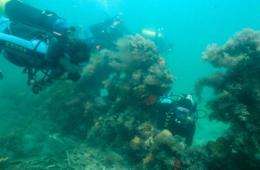Shipwreck to give up its history

The secrets of the deep will be uncovered when archaeologists excavate a significant colonial shipwreck in Victoria's Port Phillip Bay later this month.
Leading Monash University archaeologist Adjunct Senior Research Fellow Dr Mark Staniforth from the School of Geography and Environmental Science and a 60-person team will examine the excavation, reburial and preservation of the Clarence, a historically significant colonial wooden trading vessel wrecked off Portarlington in 1850.
Dr. Staniforth, a specialist in Australian colonial shipbuilding and maritime archaeological excavation and one of three chief investigators on the three-year Australian Historic Shipwreck Preservation Project (AHSPP) said Australian wooden shipwrecks had huge potential to tell us about historic connections, technological innovation and daily life in colonial Australia.
“Their archaeological potential is often under enormous threat from natural and human impacts and we must find ways to preserve them for future generations,” Dr. Staniforth said.
“One of the main aims of the project is to develop a protocol for the excavation, recording and reburial, as well as the preservation of significant shipwrecks and their associated artefacts on the sea bed.”
Excavation work will start on the site on 16 April and continue for a month. It will involve maritime archaeologists and conservators from Monash University, UWA, the Australian National University, the Western Australia Museum, the Australasian Institute for Maritime Archaeology, and many State and Territory museums and heritage authorities as well as students and volunteers. Six maritime archaeologists from Thailand, Indonesia, Cambodia, Philippines New Zealand and the USA have also been invited to participate in the research.
“The research will foster the development of a consistent national methodology for shipwreck and artefact storage and preservation underwater. It will be critical to the future development of national, and international, policy and guidelines for site managers of historic wrecks,” Dr. Staniforth said.
“The researchers will record the degree to which domestic versus traditional (namely British) shipbuilding techniques were used, study how shipbuilding methods were designed to suit new environments and the use of different timbers.
After recording artefacts in purpose-built laboratories, artefacts will be re-buried in controlled environments so specialist conservators can monitor them over the next three years.
“This project offers an ideal pathway for developing a national collaborative approach to the sustainable management of maritime cultural heritage.”
The project is supported by the Australian Research Council.
Provided by Monash University




















